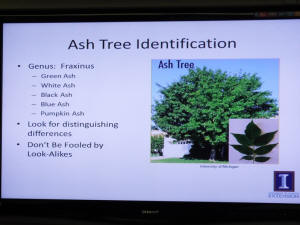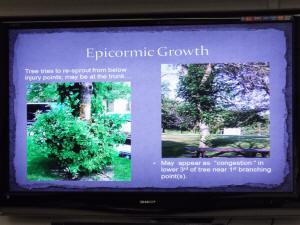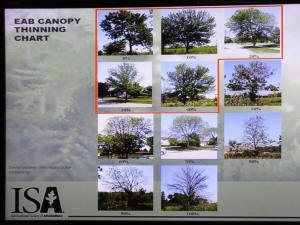|
 The Emerald Ash Borer (EAB) has been slowly making its way into
the Midwest from the Eastern United States. In 2014, Logan County
was officially added to the EAB quarantine list along with Sangamon
and Menard Counties. According to Scott Schirmer with the Illinois
Department of Agriculture’s Bureau of Environmental Programs, in the
city of Lincoln four EAB traps were set last year, and of the four,
three resulted in collecting the undesirable insect. The Emerald Ash Borer (EAB) has been slowly making its way into
the Midwest from the Eastern United States. In 2014, Logan County
was officially added to the EAB quarantine list along with Sangamon
and Menard Counties. According to Scott Schirmer with the Illinois
Department of Agriculture’s Bureau of Environmental Programs, in the
city of Lincoln four EAB traps were set last year, and of the four,
three resulted in collecting the undesirable insect.
The meeting Thursday was hosted by the University of Illinois
Extension Educator Jennifer Fishburn. Guest speakers included
Schirmer, Aaron Schulz; a Certified Arborist with King Tree
Specialists, Inc. from Tremont, and Reinee Hildebrandt, a State
Urban Forester for the Illinois Department of Natural Resources.
Jennifer Fishburn, Universtiy of Illinois Extension Educator for
Logan, Menard and Sangamon Counties
Fishburn began the morning talking about tree identification. She
noted that there are several species of tree that have strong
similarities to the vulnerable ashes, and there are also ash tree
classifications that are not affected by EAB.

Fishburn said that
folks should not automatically assume they have it. She said, often,
the first step is to figure out for sure if a tree is a vulnerable
Ash species. She said, for example, the Mountain Ash tree is not a
true Ash tree. Fishburn said the trees that may be affected are the
Green Ash, White Ash, Black Ash, and Blue Ash. In this area, most of
the true Ash trees will be either Green or White.
She talked about identifying the tree in winter with no foliage as
well as in the summer when the trees are leafed out.
In looking at a defoliated tree, look for a compound leaf stem. On a
twig from the tree, there will be bud scales. She said the bud scale
on the Green Ash will look like capital letter “D” turned on its
side. The White Ash bud scale will appear to look more like a grin
or smiley face.
When the trees are leafed out, the leaf will be in a cluster of
seven with three sets being directly across from one another and a
single leaf on the tip.
The bark of the Ash tree will be light and have somewhat of a
diamond shape texture.

Fishburn also pointed out the varieties of “look-alike’s” that often
confuse homeowners. She said trees such as Shagbark Hickory, Pecan,
Mountain Ash, Dogwood, and Chestnut are often mistaken for Ash
trees.
Scott Schirmer with the Illinois Department of Agriculture’s
Bureau of Environmental Programs
Scott Schirmer was the next speaker of the morning. He said that to
date, ash tree deaths in the United States is exceeding 350 million.
In Illinois, approximately 290 communities have been identified as
having an EAB presence. Currently, the scope of the infestation in
the U.S. includes a geographical area eastward from New York State
to Iowa and southward from Michigan to Tennessee.
Schrimer explained that the EAB is an Asian insect that has come
across the ocean through various exported items. He said that part
of the problem is that the Asian countries don’t do as good a job of
monitoring the wood products they use for pallets and shipping
materials. A number of insect species have entered the United States
by that means. He warned that there would certainly be more in the
future. He also noted that the Eastern European countries are more
careful than Asian countries, and the U.S. sees fewer problems from
that part of the world.
Once the insects make their way to the U.S., they search out living
trees in which to take up residency. A chain reaction or cycle then
begins where that the insects spread across an area via domestic
wood products such as firewood.

Schrimer discussed the role of the Illinois Department of
Agriculture’s role in monitoring the EAB. He said that the USDA
identifies the situation as an EAB Emergency Program. The components
of the emergency program include surveying and identifying the
presence of the EAB. The agency is responsible for quarantining
affected areas and monitoring quarantine compliance. The USDA also
provides community education and outreach as well as doing research
on the control and eventual eradication of the EAB.
He spoke of identifying a problem through the typical “D” shaped
openings going into a tree and noted that these are hard to find.
Other symptoms of EAB will more than likely be noticed before the
“D”, and also after it is too late to do much to save the tree.
The EAB causes its damage by burrowing under the bark of the Ash
tree where it lays its eggs for the next generation. It is the
larvae that do the actual damage by eating the layer under the bark
that transfers nutrients from the root system to the upper portions
of the tree. The larvae travel upward in a snaking pattern that
interrupts the nutrient transfer.
Schrimer said that it would take a large infestation of the EAB to
cause significant damage. He said 10, 20, or even 30 individual
larvae won’t kill a tree, which is why early detection is the most
important aspect of saving a tree.

Schrimer pointed out some signs that a tree is in trouble. One
significant indicator is Epicormic Growth. In that scenario, the
tree will try to save itself by growing branches and leafing out
below the EAB damage on the truck. Another significant sign is
woodpecker damage. He said woodpeckers will go in search of the
larvae that they know is there. The result is, they will completely
peck apart the trunk of a tree.

And finally the tree will tell you it is in trouble through
reduction of the leaf canopy. Schrimer said the reduction of the
canopy will begin at the top and spread downward in most all cases.
He offered a slide showing reduction of the canopy by percentages, 0
through 100. He told the group that trees with 10, 20, 30, or even
40 percent reduction can still be saved. When the reduction reaches
50 percent or more, he said the best action would be to fell the
tree and replace it.
[to top of second column] |

He also cautioned that when one is trying to determine
whether or not to save or destroy, consideration has to be given
not only to the cost of each solution, but also to public
safety. With several members of the Lincoln Street Department
on hand, Schrimer said that as the damage spreads, a tree will
become brittle. Because of this, branches will break and fall
easily, there are perils for workers in trying to trim the dead
material from the trees, and catastrophes can happen.
Addressing the city staff, Schrimer said that it is very important
for municipalities to have tree inventory records. He showed
examples of inventory records. On the records, he identified the
tree species, its location, and its condition. He uses a ranking
system to help him know what stage of life the tree is in with a
class 1.0 being a newly planted young tree to class 5.0 being a
mature, but dead tree that needs removed.
It was also suggested that a municipality use a wide variety of tree
species with population percentages on any one variety not exceed 10
percent or so.
He noted that EAB is not the first tree killer to come into the
United States, and it will not be the last. He said there are other
threats right now that will more than likely eventually become an
issue in the Midwest. He specifically named the European Gypsy Moth
and Asian Gypsy Moth that prey on Oak trees and the Gold Spotted Oak
Borer, which he said was the "EAB of the Oak."
Aaron Schulz, Certified Arborist with King Tree Specialists, Inc.
Aaron Schulz was the third speaker. He discussed means of
controlling EAB through the use of pesticides. As a professional who
specializes in this area, he talked primarily about professional
grade insecticides and how they are applied.

Like Schrimer, he cautioned that there is a point when treatment is
not the best answer. Using the same slide Schrimer used, he told the
group that he would not treat a tree that has exceeded 40 percent
canopy loss.
Also, when considering treatment or removal, cost is going to be a
factor he said. The products, Schulz spoke about the most, were
Xytect, Safari, and Tree-age. The products are applied either as a
drench at the base of the tree, soil drench or an injection into the
trunk collar.

To determine the treatment cost; the tree is measured in diameter at
4.5 feet above the soil level. This measurement is then identified
as the “DBH.” Pesticide treatment can cost between $6 and $12/one
inch DBH depending on the type of treatment.
Removal of a tree includes a number of costs, from cutting and
removal to stump removal and depending on the size of the tree can
be very costly. Schulz said that for younger trees that have less
than 40 percent EAB damage, annual or bi-annual treatments can be
administered for a number of years before the cost would exceed the
cost of removal.
Reinee Hildebrandt, a State Urban Forester for the Illinois
Department of Natural Resources
Reinee Hildebrandt was the final speaker of the day. As a member of
the Illinois Department of Natural Resources, she was representing
the Tree City USA certification program. She noted that the city of
Lincoln is already a Tree City and applauded the city for the
investment it makes each year in sustaining its urban forest.
She noted that the city of Lincoln spends $5.41 per capita on its
urban forest. She said the figure is well above national figures but
below the state average. She too talked about the importance of
having a tree inventory and also of having a wide variety of trees
in that forest.
She suggested that the city create a volunteer tree board to assist
in the inventory and management of the tree population. She also
noted that the city's tree ordinance may need to be tweaked a bit.
She specifically suggested that the ordinance not name the trees
that are allowed or not allowed within city limits.
Currently, the city ordinance has a short list of approved for
planting and a list of forbidden trees. Hildebrandt said the city
should remove those conditions and replace it with “for a list
contact the city forestry department.” She said this would give the
forestry department the opportunity to amend the list as needed
without having to go through the time and expense of amending the
ordinance.

Finally, she talked about grant and other funding opportunities to
help support the cost of EAB control. She suggested that there are
grants available through the IDNR as well as a private corporation
called Treefund.org. She said that the Illinois Financial Authority
has low-interest loans available. She also suggested soliciting
local groups and clubs such as garden clubs, 4-H and Boy Scouts. She
noted that an urban forest project could be a great one for a Scout
working toward Eagle status.
During the discussion period, one of the most significant questions
came from the Lincoln Street Department and pertained to disposal of
the trees once they are cut.
Once cut, it is safe to run the trees through a wood chipper for
mulch, and it is also acceptable to burn the trees.
Another question: Once a tree is cut, how long would it take the
insects to move out of the tree and into another?
The answer: When the tree is cut with the insect in its larvae
stage, it cannot move. Eggs are laid in the fall, so if trees are
cut and destroyed in the late fall, there would be no opportunity
for the insect to escape to another tree.
[Nila Smith]
The University of Illinois has a vast
amount of information, including illustrations, to assist homeowners
in identifying EAB in their landscapes. To view the website follow
this link:
http://web.extension.illinois.edu/firewood/eab.cfm
Past related
article
Emerald Ash Borer Found In Logan, Menard, and Sangamon Counties
By John Fulton |